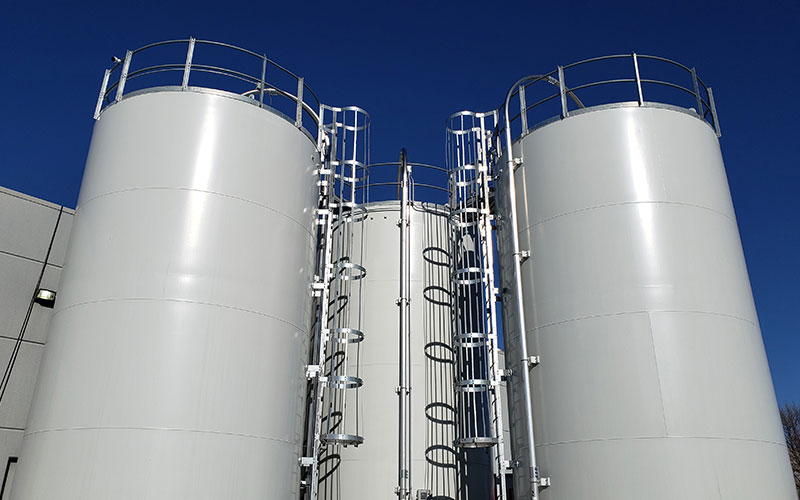by Jenny Nielson Christensen, MBA, vice president of marketing, BinMaster
Imagine your job didn’t involve climbing silos, guesswork or inventory shortages. Instead, each day you stayed safe; and inventory was convenient, accurate and reliable. That’s what level sensors and software can do for your plant – easily and affordably.
Measurement starts with the sensor
In most cases, the most important job of a level sensor in a resin silo or hopper is to ensure adequate resin is flowing through the system to avoid process interruptions and reduce cycle times.
Level sensors are easily installed or retrofit on most any resin silo. Level sensors measure distances with high levels of accuracy, generally within +/-0.2″. The types of sensors best suited for plastics are immune to the noise and dust that occur when filling the silos. They report inventory levels in real-time and are highly reliable, with a long service life and minimal maintenance.
Sensor technologies to measure pellets, powders or flakes
A dust-penetrating noncontact radar is the go-to sensor for noncontact continuous level measurement. The advent of narrow-beam 80 GHz technology ensures reliable operation in dust and fast update rates. However, there are other types of sensor technology that may be better suited to the application or to the budget.
A scanner that can measure multiple points on the material surface can account for surface variations of the resin in the silo as well as conditions such as cone up or down to account for irregularities when calculating volume.
Bob-style or weight-and-cable sensors work much like a tape measure. They take measurements at predetermined time intervals such as once an hour, several times a day or on demand. They have been utilized in plastic applications for more than two decades and are budget-friendly, mechanical devices with a long service life.
A battery-powered laser level sensor can be used if conduit and power are not readily available. This type of sensor can save significantly on wiring costs and hiring electricians. Laser technology performs best in low-dust applications typical of many pellet silos.
Measure liquid polymers or additive tanks
Noncontact radar level sensors also can be used in liquid applications at plastics plants. Liquid resins and plasticizers are easily and continuously measured, even if condensation or turbulence are present. An 80 GHz level sensor can accommodate liquid tanks commonly 8′ to 12′ diameter and 20′ to 30′ tall.
Caution: A level sensor is not a scale
It is important to understand that level sensors measure the distance to the material from the sensor at the top of the silo. They don’t weigh anything. If the expectation is an accurate weight, a strain gauge or load cell may be a better option. This type of technology is best installed at the time a silo is commissioned, as it is extremely difficult (sometimes impossible) and expensive to retrofit in an existing silo.
Simplicity lies in the system
Thanks to sophisticated software that does the math for you, the distance to the resin can be converted to an estimate of mass or volume. The accuracy of the estimate is dependent upon entering the correct silo dimensions into the software and the evenness or irregularity of the piling or topography of the resin in the silo.
Processing and purchasing personnel can rely on the software for timely alerts and trend reporting. They need to see their silo inventories in multiple areas in the plant as well as when they are off site. Readings in the software program also are used by purchasing managers to monitor inventory, place orders in a timely manner and know when to schedule deliveries.
User-friendly software platforms
As far as software is concerned, users need to determine if the software should be installed on a local area network (LAN) to access from a PC or a cloud-based software-as-a-service (SaaS) and accessed from the internet on a phone, tablet or PC. Both are easy to work with and highly affordable. A software program installed on your local network is a one-time software purchase per plant location. The software accommodates up to 120 silos. Cloud-based programs typically are subscriptions based upon the number of silos you are monitoring. The cost can be several dollars per month per silo, plus a cellular program if one is needed. Cloud-based programs have the benefit of not requiring an IT expert to install or manage the program. Updates to the software are provided by the host company, which also will provide the necessary training and ongoing support.
Both LAN and SaaS programs offer similar features. Both have easy-to-use, graphical interfaces. Bins can be sorted by type and status. An administrator can control who has access to the program and what information is available to users. Historical reports can be quickly downloaded for specific time periods.
Perhaps the most loved feature of inventory management software is automated alerts. Sent via text or email, these alerts help plants ensure that silos or hoppers don’t run empty and interfere with production. When used in tandem with purchasing, orders can be placed in a timely manner and deliveries scheduled so as not to interfere with production.
Point level indicators prevent overfills and hopper outage
A point level indicator alerts when resins reach a certain point in the silo or hopper. Indicators are commonly used to prevent overfilling resin silos and ensure that hoppers have adequate material to feed into the molding process. They do not measure continuously, but instead indicate when material reaches a certain point.
Rotaries are the most tried and true level control. They operate by rotating a paddle in the material so that when it reaches the level of the paddle, it stops turning and sends an alert via a relay. Conversely, it can alert to a low level in a hopper if the resin falls to a level below the paddle and starts turning. These devices are offered with paddles for very light to heavy resins. Rotaries are inexpensive, last a long time and are offered in fail-safe models if supplying material consistently is critical to a process.
The vibrating rod is another point level sensor commonly used in plastics. It works by vibrating when uncovered; when the vibration stops upon being covered by resin, it sends an alert. It has sensitivity settings that can be adjusted for pellets or powders. A vibrating rod is not recommended if static electricity is present because it can cause the material to cling to the blade and create a false signal.
For large, active hoppers that need continuous tracking, a noncontact radar can track levels in real time and update in just seconds.
Customize the system to the operation

As inventory systems are very flexible, they are used in most any size of operation. An important budgetary consideration is scalability. Some plants want to add level sensors to silos incrementally or choose to selectively monitor only silos that are very active.
Vendor-managed inventory can be a valuable strategy for molders. Providing resin suppliers access to inventory enables them to be proactive in ensuring supplies are adequate and deliveries are scheduled to prevent shortages.
Different materials may require another type of sensor technology. For example, dust can impact the short-term performance of some technologies that have trouble seeing through dust while the silo is being filled.
It is easy to have a variety of sensor types at a single location, each suited to the size of vessel and the type of resin in it. There are sensors compatible with analog or 4-20 mA outputs, Modbus or HART that can be applied as needed for the job to be done.
For the most part, equipment used by compounders, extruders, injection molders, rotational molders and refiners is very similar. What you are molding doesn’t matter so much as how active the vessel or hopper is.
Jenny Nielson Christensen, MBA is vice president of marketing for BinMaster, a division of Garner Industries. Her mission is to train and educate industrial processors on how to streamline operations, increase productivity and enhance profitability through sensor and software technology.
More information: jchristensen@binmaster.com or 402.434.9125
Three Things to Consider When Specifying a System
1. What is the type, size or number of silos?
If there is material in a silo, tank or hopper, there is a sensor to measure it. Begin designing your system by creating a list of the silos, their dimensions, the type of resin stored inside and any existing equipment installed or used on the silo. This ensures the sensor can be matched to its job. Nuances such as access to, or structure in, the vessel also may be contributing factors to sensor specification.
Also note if the silos are grouped in any way by location. Silos grouped together physically can be addressed with wiring configurations, such as daisy-chaining. Silos distanced further from power can be good candidates for battery-operated sensors and wireless devices.
Resin silos are primarily made of bolted steel or smooth-walled aluminum and are about 12′ to 14′ in diameter and range from 30′ to 60′ tall. Most plants have less than six silos, with a few having more than 20. However, the system also can be used across multiple plants or corporately for hundreds of silos.
Pellet dryers, day bins and coolers also are excellent candidates for level sensors and inventory monitoring. They can be added easily to the same system as silos.
2. How frequently do measurements need to be updated?
Consider if you want measurements updated constantly or if readings at intervals throughout the day will suffice. Continuous level sensors do as the name implies… they update continuously and in real time. Readings taken at preset time intervals or on demand also may work for your plant. Technologies such as radar update in just seconds, while wireless laser is best for intervals every hour or three to four times a day to conserve battery life. Some cable-based systems can be programmed at set time intervals, such as marking the beginning or end of a shift. These also can take a measurement on demand with the push of a button or be set to measure every couple of hours.
3. Where do people need to see the data?
From a communications standpoint, determine where people need to access the data. Solutions can be designed to offer visibility from a control room, office, remote location such as corporate headquarters or from home. SaaS offers the option to log in to view inventory anywhere you have an internet connection.
Another common device to provide convenience in the plant is a control console or digital panel meter. These can be installed for walk-up or drive-up access, indoors or outdoors. For example, a driver delivering resin should check the silo level before starting to pneumatically load resin into a silo. The driver can confirm the entire load will fit into the silo and prevent the risk of overfilling. These push-button devices are easy to use and can be used for view-only access to data on the plant floor.





